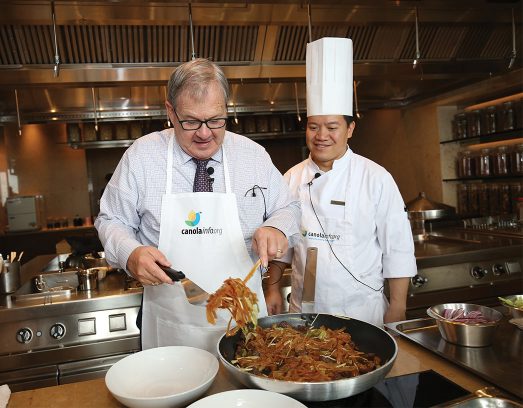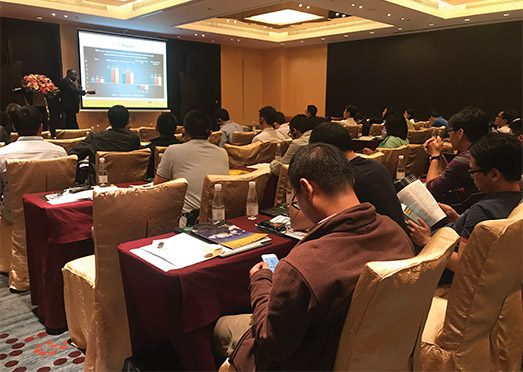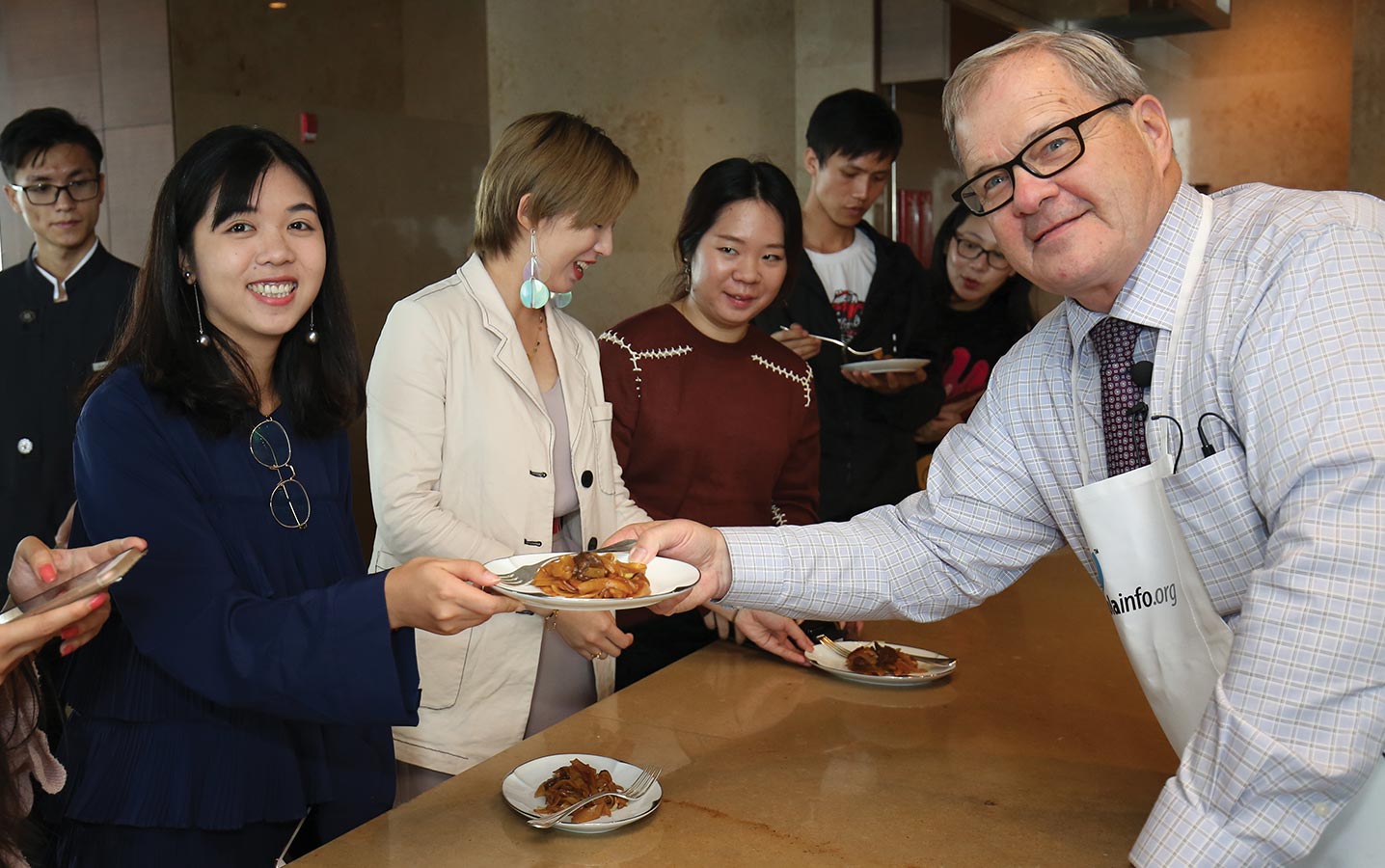China gets to know canola
When Bruce Jowett asked three years ago to make a presentation on canola to the Chinese Nutrition Society, the society was confused with what he wanted to talk to them about, “What? Granola?”
From that first encounter, work to promote the health and functional benefits of canola in China has paid off. Jowett, the Canola Council of Canada (CCC) vice president of market development, says the Nutrition Society is now adding canola oil to its nutrition standards.
“My job is to first raise awareness of canola oil in China and then differentiate Canadian canola oil from other options,” Jowett says. “With enough of the Chinese population saying ‘we want canola oil,’ it might help maintain stable and open trade.”
He still has a lot of work to do. With efforts focused on Beijing and Shanghai the past few years, awareness is starting to tick upward. Thirty per cent of the decision-making 28- to 45-year-old food shoppers in those two big, cosmopolitan cities have now heard of canola oil and eight per cent have used it in the past year, Jowett says, but canola has not displaced other products in home pantries in any big way, yet.
China is a large and diversified market for vegetable oils, which is no surprise given its huge population, regional cuisines with distinct oil tastes and uses, and its variety of domestic oilseed crops. According to the United States Department of Agriculture (USDA), China’s total domestic consumption of oil for food use will be 34 million tonnes in 2017-18. This includes 17.4 million tonnes of soybean oil and 8.1 million tonnes of rapeseed oil, the top two.
While China does produce some soybeans and a large crop of rapeseed, domestic supply is well below demand. USDA 2017 data say China imported 97 million tonnes of soybeans and 4.7 million tonnes of rapeseed as well as 700,000 tonnes of soybean oil and 800,000 tonnes of rapeseed oil that year. (Rapeseed stats include Canadian canola.)
China has a long tradition of using rapeseed oil, and Chinese rapeseed breeders have developed some low-glucosinate and low-erucic-acid varieties. CCC canola meal manager Brittany Dyck estimates that these double-low varieties could account for a significant amount of China’s rapeseed acres in a year, although quality is highly variable. This inconsistency in quality and taste from the domestic rapeseed supply creates some confusion for consumers and the livestock producers in China, Dyck says. High quality and uniformity of the Canadian crop is the Canadian advantage for canola market development efforts in China, she says.
Opening up the south
Read about the first ever “Canola Dialogue” event in China. The Dialogue, which may become an annual event, is designed to maintain open communication – and hopefully open trade – between Canada and China.
To expand canola familiarity beyond Beijing and Shanghai, the CCC hosted canola oil and meal events in Guangzhou in November 2017. On the Pearl River, 2,000 km south of Beijing, massive Guangzhou is the capital city of Guangdong, the most populous province in China.
At the Guangzhou oil event, Chef Ken Liang showed how canola oil works well with traditional Cantonese food preparation and taste, and Chinese nutritional expert Dr. Nancy Liu spoke to influencers, key opinion leaders and media on the health benefits of Canadian canola oil. Dr. Liu has been delivering the canola health message for three years in China. She told attendees that cardiovascular disease and stroke are the leading causes of death in China and that 12 per cent of Chinese adults have diabetes. Then she made her pitch for canola oil. “Choosing unsaturated fat, especially monounsaturated fat, is critical for those with diabetes, and plant-based omega-3s can reduce inflammation,” she says. “If you have only one oil, make it heart-smart canola oil.”
Media representatives at the Guangzhou event took these canola messages and wrote 55 stories that reached 142,680,000 potential readers.

Promoting canola meal for Chinese hogs
Nearly 40 feed buyers and ration-mixers from large industrial-sized farms came to the CCC’s Guangzhou canola meal seminar held the day before the oil event. Researcher Martin Nyachoti from the University of Manitoba shared his large body of research on feeding canola meal to pigs in all stages of production.
Brittany Dyck says the event was a chance to explain to these key decision-makers the differences between rapeseed and canola meal. “High glucosinolate levels in rapeseed were reducing inclusion levels for Chinese rapeseed in swine rations,” Dyck says. “Our goal is to have leaders in the swine industry identify canola and rapeseed as different, and then to maintain them as separate sources.”
To track the success of the meal event, the CCC surveyed attendees before and after the seminar to understand how their views on canola meal as a feed ingredient for pigs changed. Only 21 per cent of surveyed participants currently use canola meal for pig diets and will only use it for pigs in the final stages of growth. All surveyed participants said that the information presented during the seminar will change how they use Canadian canola meal in swine diets in the future.

Road blocks
Canada exported $6.2 billion in agri-food and seafood products to China in 2015, and canola alone accounted for half of it. Through the AgriMarketing Program, the CCC receives funding for its market development and market access activities in China. Market access efforts to increase understanding, to prevent issues by monitoring regulatory changes and to resolve issues are essential for stable and open trade with China.
For one thing, the tariff on Canadian canola seed is nine per cent while the tariff on soybeans is three per cent. (Tariffs are nine per cent for both soybean and canola oil and five per cent for both soybean and canola meal.) Other issues specific to canola include stalled approval of new biotech traits and sanitary and phytosanitary (SPS) issues with regard to blackleg. While Canada and China have a blackleg agreement that extends to 2020, this issue is not permanently resolved.
China is already an important market for Canadian canola and, with a clear need to insert a healthy oil into their traditional cooking methods, the potential for canola use in China can rise. But it takes constant effort. The meal and oil events in Guangzhou in November are just two steps.
Jowett uses a football analogy to describe the market development process: “It takes time to work the ball down the field. You can’t do it with one long bomb.”
Jay Whetter joined the CCC on the China mission in November 2017. Funding for his travel was provided through Growing Forward 2, a federal-provincial-territorial initiative.





